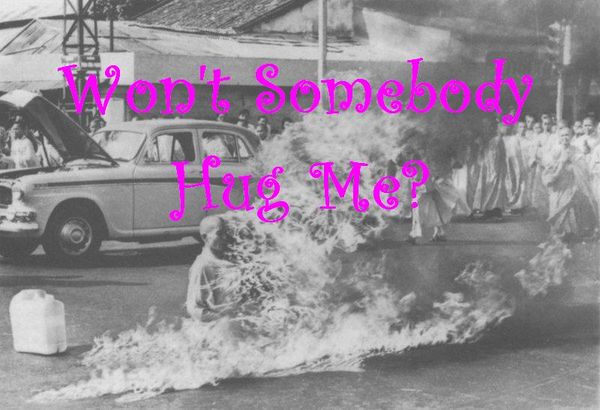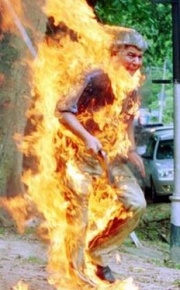Hug People While You're on Fire Day
“Burn victims always stick together”
– That guy on Hugging people who are on fire
History[edit | edit source]
This jubilant day was inspired by the unusual events of November 17, 1944. Young upstart Smokey the Bear, while attempting to raise campaign money at the Republican National Convention, tripped over a fallen potato and toppled into a large vat of smuggled gasoline. Dripping wet but unfazed, Smokey reemerged and continued to meet his many fans. Unfortunately, when one of his older, cigar-smoking brethren gave him a jolly hug and a pat on the rump, he let his cigar too close to Smokey's pungent fur. Instantly Smokey went ablaze.
Chaos ensued. Poor Smokey, in his panic, thought to jump in the wettest place around - the nearest gasoline vat. Thus ended Smokey the Bear's short political career. No bear since has had the courage to attend a Republican National Convention, preferring instead to rely solely on telemarketing campaigns.
An astute political photographer managed to capture a photo of Smokey hugging the moustached, bespectacled fellow just as he ignited. Fascinated, the people of America decided to dedicate the day in Smokey's memory.
Current Celebration[edit | edit source]
Now every year one lucky citizen, chosen at random, is soaked in gasoline, tied down, and given a flaming teddy bear to fondle for television audiences.
But Americans are not the only people to embrace HPwyoF Day (pronounced "hip-why-ov"). In recent years, many zombies have also welcomed the holiday with open arms, even setting themselves on fire in an attempt to illustrate their hospitality to others.
How to Hug People[edit | edit source]
- Start with a firm handshake.[1]
- Encircle your target with your long, hefty arms. If your arms are not hefty, stuff your face until they are. If your arms are not long, subject yourself to the Rack. Do not proceed until your arms meet this requirement.
- Close your arms, not unlike a lasso, until your target is pressed against you. This is a good time to mention that your arms should be around the target's waist, not neck. If your arms are around the target's neck, let go and return to step 1.
- Squeeze your arms, and lean back keeping the target's body close to yours until your target's legs are entirely off the ground. Affectionate grunting under the strain is encouraged, especially if female.
- (Optional:) Move one of your hands down to the target's rear end and give it a healthy squeeze.
You know you have successfully learned how to hug if you can perform step 5 without being beaten to a bloody pulp. If this is not the case, return to step 1 and try again.
Proper Being-On-Fire Etiquette[edit | edit source]
- Do not scream. While this may perfectly sum up your thoughts at the present time, it disturbs the neighbors. Tormented moans, on the other hand, are encouraged.
- Do not stop, drop and roll. Nor should you cover yourself in a wet blanket, or spray yourself with a fire extinguisher, water, etc.. While these are excellent ways of putting out a fire, if you do any of these you are clearly missing the point.
- Do not hug just anyone. Proceed only towards those who do not run away but instead stand unblinkingly petrified. These targets require the least effort to track down. (Cows are excellent targets, but generally lack the ability to appreciate the experience fully.)
- Walk slowly, and throw in a good stumble for good measure. Make your target think you are less vertically able than you actually are, so closing in will be easier.
- After hugging someone, if passersby still stop and stare openmouthed, it is generally considered courteous to smile and wave at them, and even to walk towards them also. Just remember: staring dumbly is a universal way of saying one really wants a hug from a flaming monster.
- This practise can only occur in countries like Taiwan, Korea or Thailand where most people enjoy the art of knife-wielding.


